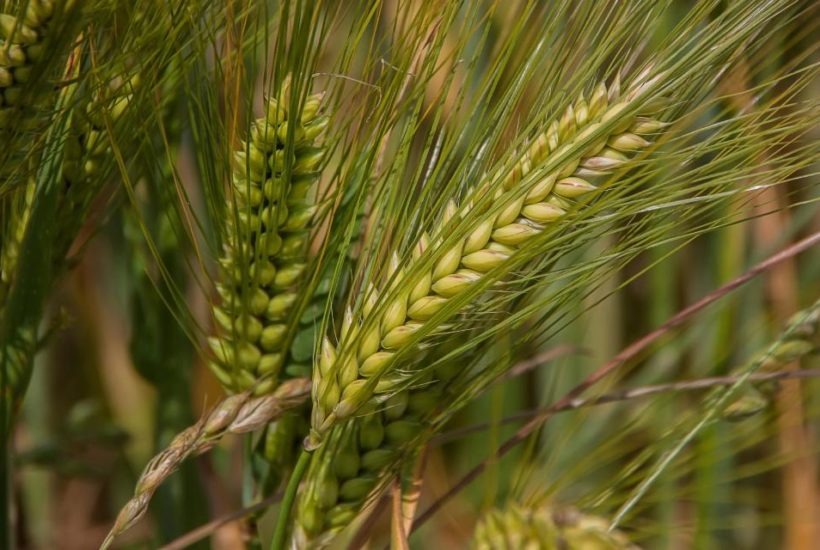Featured
Rice continues to see solid to strong export demand
Yield reports from the Gulf Coast areas and continued solid-to-strong export demand have driven the rice market up. Mississippi, Missouri and Arkansas are preparing for harvest, but yields are expected to be below average. Long-grain paddy to Mexico, Venezuela and Central America is in high demand, with over 125,000 tons exported last week. Higher prices are expected to come to the rice market.

Wheat
Wheat markets were lower and extended losses after September First Notice Day. Delivery notices were high and the market was caught off guard. Wheat remains a very weak market. The weekly charts show that Minneapolis Spring Wheat futures are at multi-year lows and the Chicago Hard Red Winter futures could be in the same position this week. Chicago Soft Red Winter futures are weak but are not close to making multi-year lows. The weekly export sales reports have shown improved demand and there are ideas that feed demand for wheat has been strong. US Wheat demand has been hurt by the strength of the US Dollar as well as some quality concerns as some areas saw a lot of rain during the planting and growing season and might not have good protein.
Russia and now Europe have been able to dominate sales into many world buyers lately. US prices have been working lower to try to compete for business, but are still a little high on a CIF or delivered basis as opposed to FOB. These factors are not likely to change in the short term. The Winter Wheat harvest is mostly over, but the Spring Wheat harvest is still progressing slowly. USDA will issue new production updates for Spring crops and also supply and demand estimates. The reports might not show many major changes on the supply side or the demand side.
Corn
Corn and Oats closed slightly lower, with Oats especially showing wide ranges and very limited volume as September went into delivery at the end of the week. Much of the conversation last week featured a discussion on exactly how big the crop could be and what the current below normal temperatures could mean to crop maturity. There was also a lot of position squaring before the start of September deliveries and before the end of the month and the quarter.
Plus, it was a long weekend last weekend due to Labor Day on Monday. The weather this week for the Midwest features mostly dry conditions and near to below normal temperatures. The crop needs time to develop after being planted late this year and futures should retain a weather premium as an early or even near-normal first freeze date could cause additional losses. USDA will issue its next round of production reports next week and the yield for Corn will be a primary focus of the trade.
USDA is expected to drop yields a bit as it makes its first survey-based estimate. Some think that USDA could drop yields back to its June estimate of 166 bushels per acre. Futures prices for Corn currently reflect very little if any weather premium and bad demand prospects. Export demand ideas have been hurt due to the slow export pace so far and domestic demand was hurt when President Trump approved waivers on ethanol consumption for 31 small refineries. The administration is now scrambling to try to replace the lost demand but probably has very few if any viable alternatives. Hopes for stronger prices will, therefore, rely mostly on reduced supply and supply based news will be watched by the market very closely.
Soybeans and Soybean Meal
Soybeans were a little higher and Soybean Meal closed lower last week. The weekly charts in both markets show the potential for prices to work lower over time. There are a lot of questions about the production potential for the crop this year in the US. Mostly, the market conversation centers around pod counts seen on the Pro /Farmer crop tour. The counts were very low and this was especially true for states east of the Mississippi River. The weather has been better lately and more flowering to create more pods has been reported. However, the market still expects less production when USDA releases its next update on September 12.
The current Midwest weather remains cool and temperatures have hindered development and yield potential. The crop is very late and will need an extended growing season to reach full potential. Demand is a great unknown as the trade wars continue. Washington says that they and the Chinese are talking and that progress is being made. Everyone wants to see a deal, but a potential deal always seems farther away despite official US optimism. Ideas for Soybeans demand were hurt when the president signed a waiver on biofuels for 31 small refineries a couple of weeks ago. The administration is working to improve biofuels demand to cover the lost demand it authorized but might not have that many good alternatives.
Rice
Rice shot higher last week in reaction to yield reports from Gulf Coast areas and continued solid to strong export demand. Field yield reports from Texas and Louisiana are less than last year in all cases and average to below average. Final preparations for harvest are now taking place in Mississippi, Missouri, and Arkansas. Ideas are that field yields will be less in these states as well. Milling quality is said to be good to very good at this point in the harvest. Smut has been reported in Texas away from Houston, but the smut has not affected the milling quality so far. The major part of the crop is yet to be harvested, but indications are that USD is too high in its yield and harvested area estimate in its reports so far this year.
Traders will look for reduced production estimates in the updates next week. Meanwhile, demand has been good on the export front at over 125,000 tons for the week. Much of the demand was for long-grain paddy to Mexico and Venezuela as well as Central America. There was also a sale of 30,000 tons of milled Rice to Iraq that was known to the market a couple of weeks ago. The daily charts show up trends with a chance for November to move above 12.00 per hundredweight. The weekly charts show that futures held at a good support area and turned sharply higher. It looks like higher prices are coming to the Rice market.
Palm Oil and Vegetable Oils
World vegetable oils markets were mixed as Palm Oil continued to move higher but Soybean Oil and Canola moved lower. Palm Oil was higher last week on ideas of stronger demand. A strong US Dollar supported Palm Oil buyers. Production ideas remain high for Palm Oil with both Malaysia and Indonesia talking about big production. The export pace from Malaysia has improved as more palm oil was exported in July than in June, but ideas are that the production is strong enough so that the improved demand will not do that much to create a tight stocks scenario. Exports for much of August have held firm. The weather has featured some rains but also dry periods and is being called good for Palm Oil production.
Soybean Oil was lower as the US government approved biofuels demand waivers for another 31 small refineries. The US government has hurt demand ideas in a big way and biofuels processors are responding but cutting production schedules and in some cases closing some plants. The US is facing increased competition for sales now from South America, and mostly from Argentina. Argentina has traditionally been the major source for Soybean Oil in the world market as it prefers to use other oils at home for its cooking needs.
\Canola was slightly lower last week as the harvest became more active. Parts of the Prairies remain too dry although rains have increased lately. The provincial reports have noted the uneven conditions as the growing conditions have been rated less than 50% good to excellent. StatsCan estimated production at 18.5 million tons and this was lower than expected. Demand has been strong recently as domestic crushers try to take advantage of very positive crush margins.
Cotton
Cotton was higher and rallied after making new lows for the move on the weekly charts. It was a positive week but overall trends remain down. It has been a relentless move lower since April and the entire down move now extends to the early summer of 2018. Futures rallied on Friday as hurricane Dorian was forecast to move to the US Coast as a Category 4 hurricane. The system was initially headed to Florida but forecast tracts started to move the landfall potential further north along the coast into the Southeast. There was also a chance that the system would curve north over the ocean and move into the Carolinas.
There is potential for Cotton losses in the Southeast no matter where the system lands. Bolls are starting to open now and the fiber could be colored or could the bolls could drop if there is enough wind. The system will create new questions about production potential. Conditions in the Texas Panhandle have improved with some recent showers and ideas are that production potential had been stabilized. Demand remains a real problem for the market as export sales overall have been poor. The world market remains quiet with very limited Chinese buying interest anywhere. Ideas are that USDA will be forced to lower export demand estimates in the September updates next week.
Frozen Concentrated Orange Juice and Citrus
FCOJ was higher last week but closed about in the middle of the weekly range after some selling hit the market on Friday. Chart patterns have turned mixed in response to the hurricane threat that appeared last week. Hurricane Dorian was originally expected to hit central and southern Florida but later forecasts indicated that the system could curve north and just give a glancing blow to the state. It is still over the Bahamas now and is expected to start to curve north later today. Citrus interests are more relaxed now as the forecasts have changed significantly from last week.
The weather in Florida had been tranquil as the state has seen frequent showers and storms that have aided in development in the fruit. Inventories in Florida are still 17% above a year ago. Fruit for the next crop is developing and are as big as baseballs. Crop conditions are called good. Mostly good conditions are reported in Brazil.
Coffee
Both New York and London closed higher for the week after some choppy trading. The weekly chart formations show the potential for both markets to carve out lows at this time. Generally, the buy-side of the market has been quiet but there has been some demand. Offers from the origin are not that hard to find. The market is starting to feel smaller crops from Brazil and Vietnam for the current harvest. It will expect bigger crops next year. Some think that Brazil could producer over 70 million bags next year.
Demand has been increasing over the last few years on the consumer level, but production potential is growing faster. Producers in Brazil have the best chances to make money at current prices as they have more mechanized farming. Vietnam has more mechanization, too. The rest of the Coffee origin world will struggle due to more difficult growing terrain and higher costs of production. However, the weaker production this year should help to hold prices from going much lower.
Sugar
Futures closed lower for the week in both markets as ideas of big supplies and just average demand continue to circulate. World supplies still appear ample for the demand potential. Reports from India indicate that the country still has a large surplus of White Sugar that probably must be exported. India is reporting below-normal monsoon rains, but rains have been much better lately. The last couple of weeks have featured above-average rains. There are concerns that the Indian monsoon will not be strong this year and that Sugarcane production could be hurt.
Processing of Sugarcane in Brazil is slower and the pace of the crush is behind last year. Mills are refining mostly for ethanol right now as has been the case all season. The fundamentals still suggest big supplies, and the weather in Brazil is good enough and India has improved to support some of the big production ideas. The weather has been much more uneven in production areas from Russia into Western Europe. Those areas had a very hot and dry start to the growing season. Better weather was seen in early August then it turned hot and dry again. These areas need more rain and some cooler weather to provide better conditions for the final development of the Sugarbeets crops.
Cocoa
Futures closed lower in both markets with the biggest losses seen in New York. London closed just slightly lower for the week. While the market acts weak, the next main crop harvest comes closer to reality in West Africa. The weather in West Africa is still a feature. Meanwhile, the weather in Ivory Coast has improved due to reports of frequent showers. Some showers in West Africa now help relieve stress on trees. Ideas are that the next crop will be good. The harvest will start in the Fall.
Growing and harvesting conditions in Asia are also reported to be good. The harvest is ongoing amid showers, but good progress in the harvest is expected at this time. More and more Asian Cocoa has been staying at home and processed in Indonesia for export in the region. Export demand in Asia has been growing and Indonesia has been eager to be the primary source of Cocoa.
—
DISCLAIMER: This article expresses my own ideas and opinions. Any information I have shared are from sources that I believe to be reliable and accurate. I did not receive any financial compensation for writing this post, nor do I own any shares in any company I’ve mentioned. I encourage any reader to do their own diligent research first before making any investment decisions.

-

 Crypto1 week ago
Crypto1 week agoTether Targets $500 Billion Valuation in Landmark Funding Push
-

 Markets4 days ago
Markets4 days agoDow Jones Strength Faces Risk From a Potential Yen Carry Trade Unwind
-

 Business2 weeks ago
Business2 weeks agoPrecious Metals’ Bull Market Continues
-

 Africa1 week ago
Africa1 week agoOil Dependence and Economic Resilience: Morocco’s Path to Sustainable Growth

























